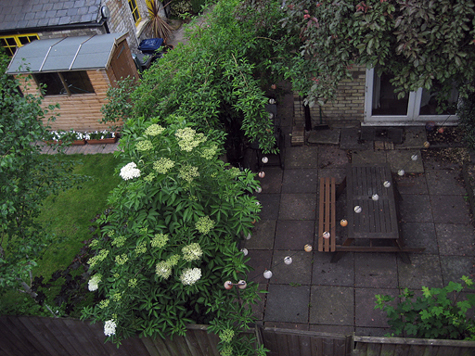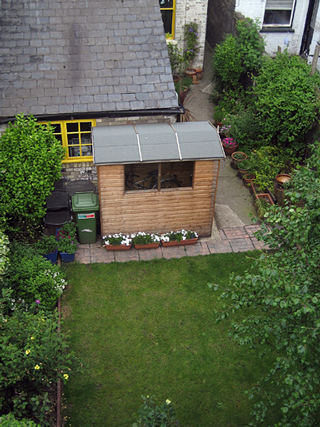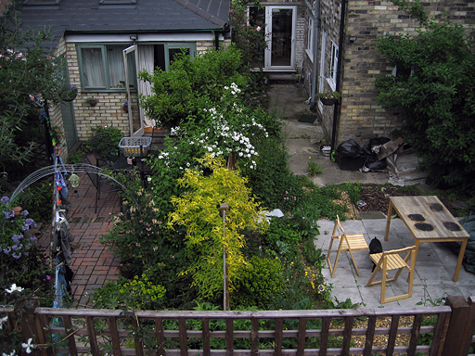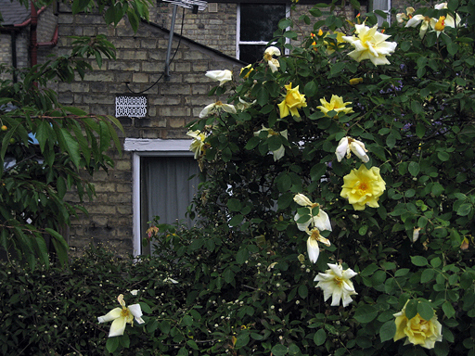Human Flower Project
Rerouting and a Spotless Rose
From the bridge, John Levett sees the hallmark of gardening—effort. At home, persistence brings a banner year for a pesky yellow rose.

Elizabeth Way Bridge, built 1971, over the River Cam
Photo: John Levett
By John Levett
I have entered the buggersome years. The years of forgetting the date of so-and-so’s birth or death; the name of a book, the name of an author; the road that leads into that other road; an artist, a sculptor. They all come back at some time but at the time when they’re no longer needed.
Until last year I was giving was a ten-session course on Marx and Marxism. I loved it then as I loved it when I first gave it. It took in the whole broad sweep of the intellectual development of a continent; there was nowhere it couldn’t go—art, literature, philosophy, history, political economy, insurrection, failure, defeat, death. Nothing was too small to be attended to—the name of the editor of an obscure north Prussian periodical; the correct title of an Austrian grand duke; the name of a street in St. Petersburg; a character in Balzac. I needed to research these things; someone might ask; I might not know; my credibility in shreds. Each week resembled the desperate last-minute revision of a final-year student on the morning of a final exam. And if nobody asked? I slotted it into an aside somewhere. Nothing of my research was wasted. Diderot’s running dog.

Neighbors, from the Elizabeth Way Bridge
Photo: John Levett
This year I decided that it was becoming a bit of a slog. The size of my project list was growing; the commitments made and back-burnered last winter were being called in; space for doing nothing becoming marginalized. I’d need to change the course to keep it fresh, revise and research new modules. No. Quit as champ.
It hasn’t stopped the research though; I’m starting again where it all began some fifty years ago. (“between the Chatterley Trial and the Beatles first LP”). I’ve long kept a list in my head of books that never got read or books that did but they’re so long forgotten they could be fresh. I’ve also thought long of doing something on film and literature as social history sources—the incidentals of keeping home, moving about, buying food, getting drunk, starting school, starting work, starting family. A visual acknowledgment (or steal more likely) of David Kynaston’s approach. I recently watched Tony Richardson’s 1961 film ‘A Taste of Honey’ and could have written an essay on it as source. It coincided with re-reading Raymond Williams’s Culture and Society from 1958 and Colin McInnes’s London Trilogy. That led to taking myself off to Skoob Books near Euston and picking up Room at the Top 1957, A Kind of Loving 1960, This Sporting Life 1960 and The L-Shaped Room 1960. Allan Sillitoe died a couple of months ago; maybe it was that that set me to it.
 View from the bridge
View from the bridge
Photo: John Levett
Last Sunday I came to the end of a reading week—nothing but sitting in the garden and breaking only for tea-making, toasting and moving with the sun. I broke for a walk around the houses and back via Elizabeth Way Bridge.
I live in Chesterton which, until the nineteenth century, was a village on the northern outskirts of Cambridge reached only by a circuitous route or by dodgy ferries over the River Cam. A new bridge was constructed in 1890 to the west but it wasn’t until 1971 that another main road, with four-lane bridge into the city centre, was built. This was Elizabeth Way Bridge. It’s single span, concrete and, most days, most times, full to brimming. It also spans the backs of a row of Victorian houses. Such was the nature of 1970s town planning that at sometime, somewhere, someone was going to find a part of traffic re-routing re-routed outside their bedroom window. Very often this re-routing happened in those parts of town that tended to be lived in by others than those who supported the governing party. Curious that.

Fences mended
Photo: John Levett
In the past, walking over the bridge, I’ve never taken much more than a cursory glance below noticing the gathering rubbish but recently there’s been a clear-up of sorts. Fences have been mended, the back pathway cleared-up, creosote and paint splashed around a bit and a bit of effort put in.
I’m always in admiration of the garden against all the odds—the fumes, the shade, the unwrappers and casters, the decades-old self-seeded laburnums, the home-decorating detritus that so often gets shoved out the back. It takes sticking-power to keep up and many don’t. There’s the trough for spring violas, there’s there grass patch for the weekend relax, there’s the barbecue affair gone to rust, there’s the single rose gasping, there’s the aspiration. Most times I have an Aristotelian view of gardening—to try is to succeed. Even if it’s just for a season.
My next door neighbour’s of the same frame of mind. She walks around the village (we still call it that because we’re pretentious that way) picking off seed heads and pinching off trailers and then a no-fuss handful of dirt into a pot (often not bothering with the pot) and off they go into magnificence or oblivion. No matter; some work, most don’t. I see her as some sort of conservationist. She does the same over on Stourbridge Common (where she walks her dog three times a day) with anything wild that crops up. She’s got an apple tree from it (four foot high now but giving fruit), herbs, wild strawberries, numerous poppies, irises and stuff that looks like rubbish but may be a rarity.

May 2010, along the Cam
Photo: John Levett
Gardening by walking around. It’s something that used to be very common but now falls to the onrush of the instant garden. The old (pre-1960) gardening handbooks that I used to collect always started off with seed-sowing. It was always the assumption that that was how the gardener would begin. It clearly was also assumed that if you’d gone far enough to buy the handbook then you were serious about your garden. You’d have your pots and seed-pans (which could be bought in Woolworths those days), John Innes compost numbers 1 and 2, space for housing and maybe over-wintering once sown and then all the time and paraphernalia of pricking-out, bringing-on, potting-up that went with it.
Seed growers and seed merchants were legion and specialists were household names. Boltons for sweet-peas was always a trip my mother and I took in September and thinking back it was a bizarre thing to do. There was nothing to see at Boltons except packets of seeds in brown paper packets with stencilled names and catalogue numbers. No illustrations, no photographs, no special offers. Just a bloke in a brown overall behind a wooden counter taking down numbers from your previously-decided-upon catalogue selection. Then off you went. Wild!
But the austerity of the transaction never seemed to matter. Coming home with the packets still seemed to be treasure trove. It was the fact of having bought hand-pollinated seed from the legendary Boltons of Haverhill that sealed the deal. Touching horticultural history it was. Most of it now gone.
But not entirely. There’s been rationalization but the old strains are still to be had (see Chiltern’s or Jelitto’s catalogues for winter reading). But the space; where to find the space. My neighbour just colonises whatever’s available around the back and front of the flats of the close where we live. She’s more of a free-spirit than me. I still need the planning stage.
Then again, in a convoluted (invented?) way we have similar characteristics. We both create via the detour—she as gardener, me as photographer.

Lawrence Johnson, spotless, with constant watering at roots
Photo: John Levett
Finally, a word about Lawrence Johnson, which grew up in Hidcote Manor in Gloucestershire. Jack Harkness said that it ‘will turn a wall into a sheet of gold before most roses are out in the summer’ and it does that. Graham Stuart Thomas said that it goes on producing throughout the summer and it doesn’t do that in my garden. Curiously, neither of them remark upon its appalling record of susceptibility towards blackspot. No more. Thanks to another of my neighbours, who is a never-miss viewer of Gardener’s World & Monty Don fan, the cure for blackspot is a constant supply of water to the roots. I pierced a pin-hole in my hose supply & draped it around the base of Lawrence Johnson. No blackspot for the first season ever! The rose season’s about two weeks behind this year and Lawrence Johnson’s almost over but it’s had it’s best season ever. My upstairs neighbour’s got roses round his kitchen window. Just like Hidcote Manor. You could pay good money for that sort of view.

